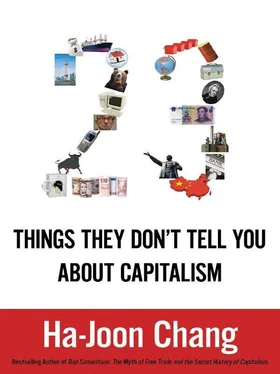1 On how tariff (hampering free trade in goods) was another important issue in the making of the American Civil War, see my earlier book Kicking Away the Ladder – Development Strategy in Historical Perspective (Anthem Press, London, 2002), pp. 24–8 and references thereof.
A. Smith, An Inquiry into the Nature and Causes of the Wealth of Nations (Clarendon Press, Oxford, 1976), p. 741.
N. Rosenberg and L. Birdzell, How the West Grew Rich (IB Tauris & Co., London, 1986), p. 200.
A. Glyn, Capitalism Unleashed – Finance, Globalisation, and Welfare (Oxford University Press, Oxford, 2004), p. 7, fig. 1.3.
J. G. Palma, ‘The revenge of the market on the rentiers – Why neo-liberal reports on the end of history turned out to be premature’, Cambridge Journal of Economics , 2009, vol. 33, no. 4, p. 851, fig. 12.
See W. Lazonick and M. O’Sullivan, ‘Maximising shareholder value: A new ideology for corporate governance’, Economy and Society , 2000, vol. 29, no. 1, and W. Lazonick, ‘The buyback boondoggle’, Business Week , 24 August 2009.
Lazonick, op. cit.
R. Sarti, ‘Domestic service: Past and present in Southern and Northern Europe’, Gender and History , 2006, vol. 18, no. 2, p. 223, table 1.
As cited in J. Greenwood, A. Seshadri and M. Yorukoglu, ‘Engines of liberation’, Review of Economic Studies , 2005, vol. 72, p. 112.
C. Goldin, ‘The quiet revolution that transformed women’s employment, education, and family’, American Economic Review , 2006, vol. 96, no. 2, p. 4, fig. 1.
I. Rubinow, ‘The problem of domestic service’, Journal of Political Economy , 1906, vol. 14, no. 8, p. 505.
The book is H.-J. Chang and I. Grabel, Reclaiming Development – An Alternative Economic Policy Manual (Zed Press, London, 2004).
K. Ohmae, The Borderless World: Power and Strategy in the Interlinked Economy (Harper & Row, New York, 1990).
An accessible summary of the academic literature on the complexity of human motivations can be found in B. Frey, Not Just for the Money – Economic Theory of Personal Motivation (Edward Elgar, Cheltenham, 1997).
The example is an elaboration of the one used by K. Basu, ‘On why we do not try to walk off without paying after a taxi-ride’, Economic and Political Weekly , 1983, no. 48.
S. Fischer, ‘Maintaining price stability’, Finance and Development , December 1996.
A study by Robert Barro, a leading free-market economist, concludes that moderate inflation (10–20 per cent) has low negative effects on growth, and that, below 10 per cent, inflation has no effect at all. See R. Barro, ‘Inflation and growth’, Review of Federal Reserve Bank of St Louis , 1996, vol. 78, no. 3. A study by Michael Sarel, an IMF economist, estimates that below 8 per cent inflation has little impact on growth – if anything, he points out, the relationship is positive below that level – that is, inflation helps rather than hinders growth. See M. Sarel, ‘Non-linear effects of inflation on economic growth’, IMF Staff Papers , 1996, vol. 43, March.
See: M. Bruno, ‘Does inflation really lower growth?’, Finance and Development , 1995, vol. 32, pp. 35–8; M. Bruno and W. Easterly, ‘Inflation and growth: In search of a stable relationship’, Review of Federal Reserve Bank of St Louis , 1996, vol. 78, no. 3.
In the 1960s, Korea’s inflation rate was much higher than that of five Latin American countries (Venezuela, Bolivia, Mexico, Peru and Colombia) and not much lower than that of Argentina. In the 1970s, the Korean inflation rate was higher than that found in Venezuela, Ecuador and Mexico, and not much lower than that of Colombia and Bolivia. The information is from A. Singh, ‘How did East Asia grow so fast? – Slow progress towards an analytical consensus’, 1995, UNCTAD Discussion Paper, no. 97, table 8.
There are many different ways to calculate profit rates, but the relevant concept here is returns on assets. According to S. Claessens, S. Djankov and L. Lang, ‘Corporate growth, financing, and risks in the decades before East Asia’s financial crisis’, 1998, Policy Research Working Paper, no. 2017, World Bank, Washington, DC, fig. 1, the returns on assets in forty-six developed and developing countries during 1988–96 ranged between 3.3 per cent (Austria) and 9.8 per cent (Thailand). The ratio ranged between 4 per cent and 7 per cent in forty of the forty-six countries; it was below 4 per cent in three countries and above 7 per cent in three countries. Another World Bank study puts the average profit rate for non-financial firms in ‘emerging market’ economies (middle-income countries) during the 1990s (1992–2001) at an even lower level of 3.1 per cent (net income/assets). See S. Mohapatra, D. Ratha and P. Suttle, ‘Corporate financing patterns and performance in emerging markets’, mimeo., March 2003,World Bank, Washington, DC.
C. Reinhart and K. Rogoff, This Time is Different (Princeton University Press, Princeton and Oxford, 2008), p. 252, fig. 16.1.
On Lincoln’s protectionist views, see my earlier book Kicking Away the Ladder (Anthem Press, London, 2002), pp. 27–8 and the references thereof.
This story is told in greater detail in my earlier books: Kicking Away the Ladder is a heavily referenced and annotated academic – but by no means difficult-to-read – monograph, focused particularly on trade policy; Bad Samaritans (Random House, London, 2007, and Bloomsbury USA, New York, 2008) covers a broader range of policy areas and is written in a more user-friendly way.
For further evidence, see my recent book Bad Samaritans (Random House, London, 2007, and Bloomsbury USA, New York, 2008), ch. 4, ‘The Finn and the Elephant’, and R. Kozul-Wright and P. Rayment, The Resistible Rise of Market Fundamentalism (Zed Books, London, 2007), ch. 4.
K. Coutts, A. Glyn and B. Rowthorn, ‘Structural change under New Labour’, Cambridge Journal of Economics , 2007, vol. 31, no. 5.
The term is borrowed from the 2008 report by the British government’s Department for BERR (Business, Enterprise and Regulatory Reform), Globalisation and the Changing UK Economy (2008).
B. Alford, ‘De-industrialisation’, ReFRESH , Autumn 1997, p. 6, table 1.
B. Rowthorn and K. Coutts, ‘De-industrialisation and the balance of payments in advanced economies’, Cambridge Journal of Economics , 2004, vol. 28, no. 5.
T. Gylfason, ‘Why Europe works less and grows taller’, Challenge , 2007, January/February.
P. Collier and J. Gunning, ‘Why has Africa grown slowly?’, Journal of Economic Perspectives , 1999, vol. 13, no. 3, p. 4.
Читать дальше






![Ally Carter - [Gallagher Girls 01] I'd Tell You I Love You But Then I'd Have to Kill You](/books/262179/ally-carter-gallagher-girls-01-i-d-tell-you-i-lo-thumb.webp)





